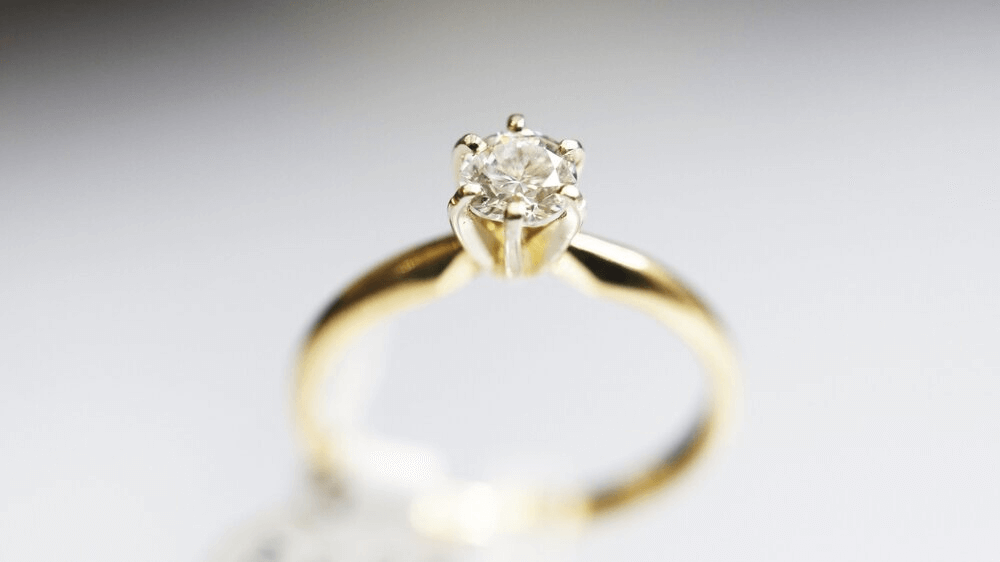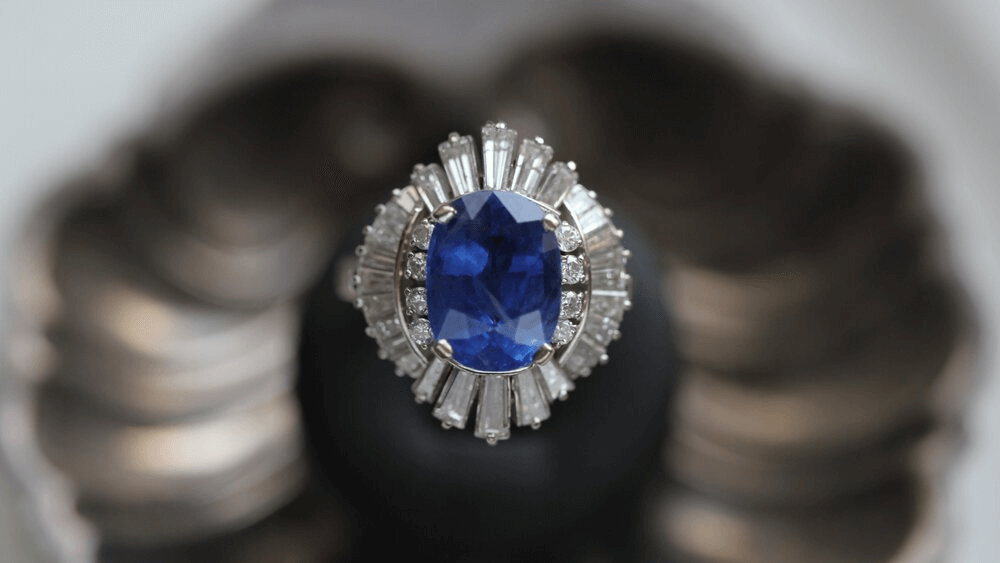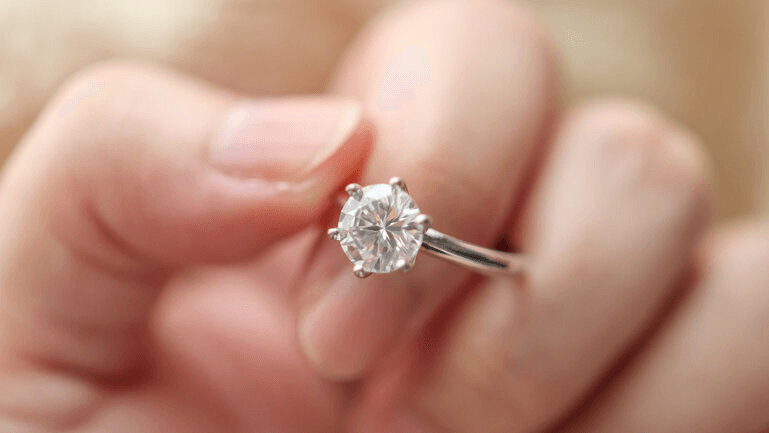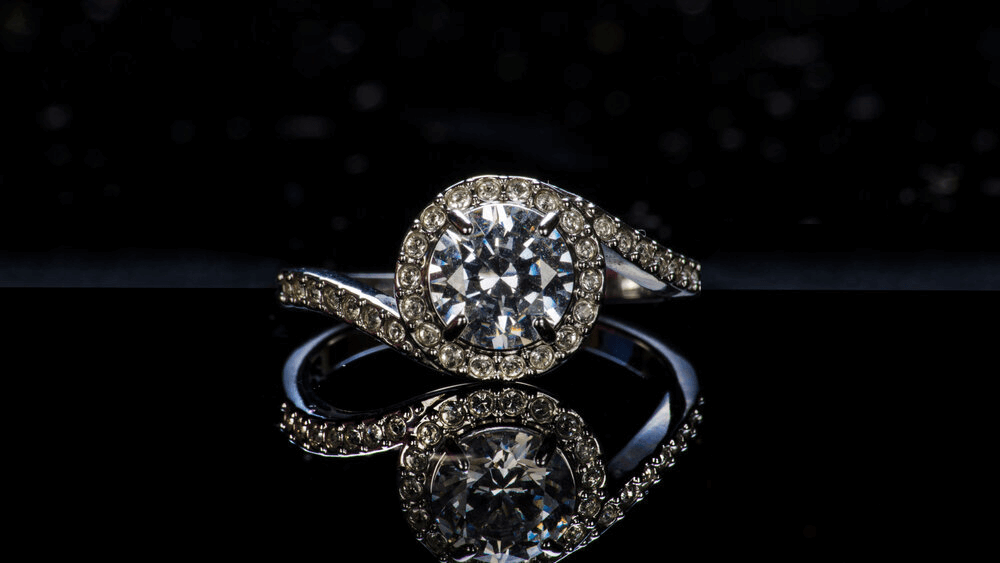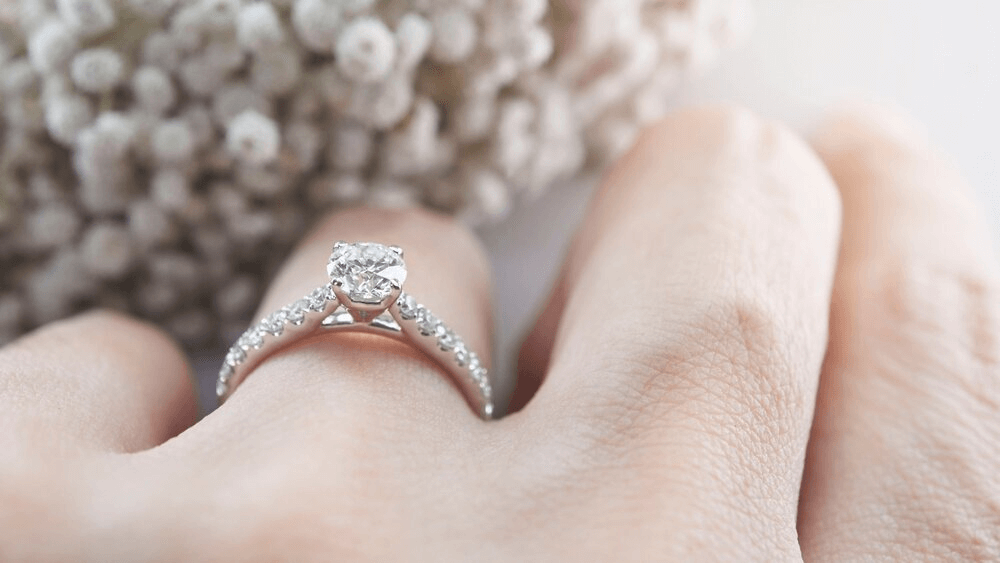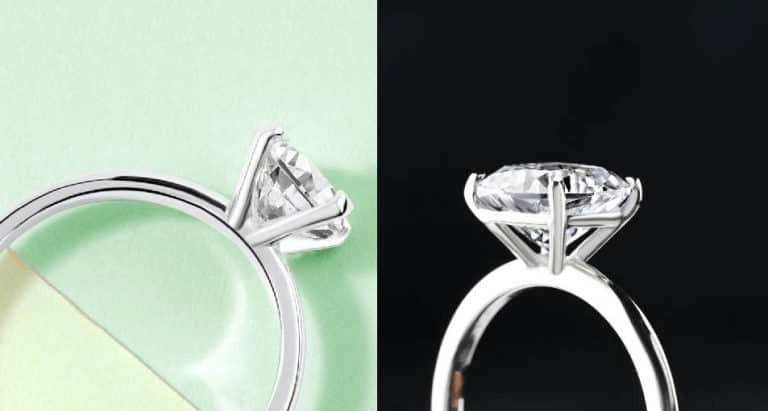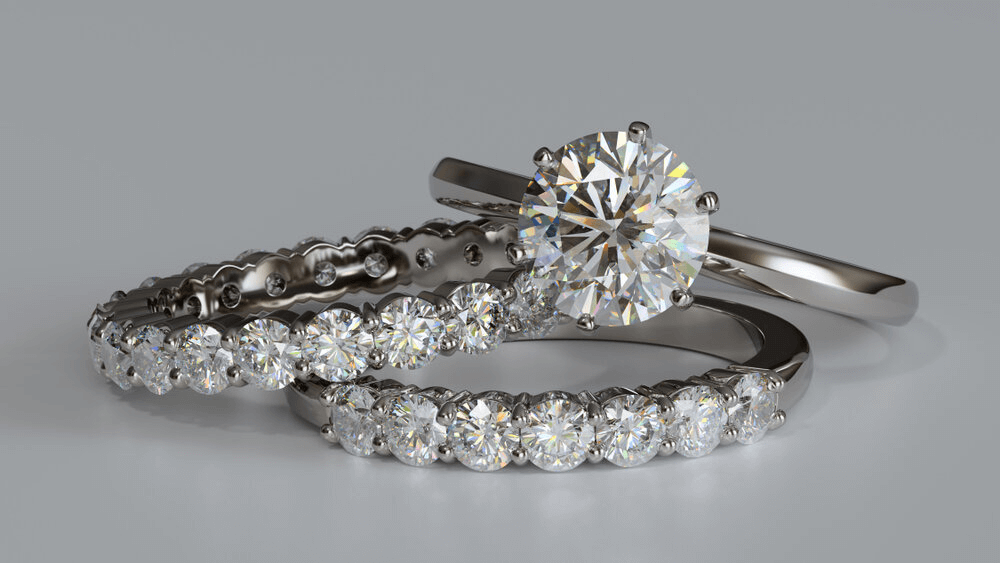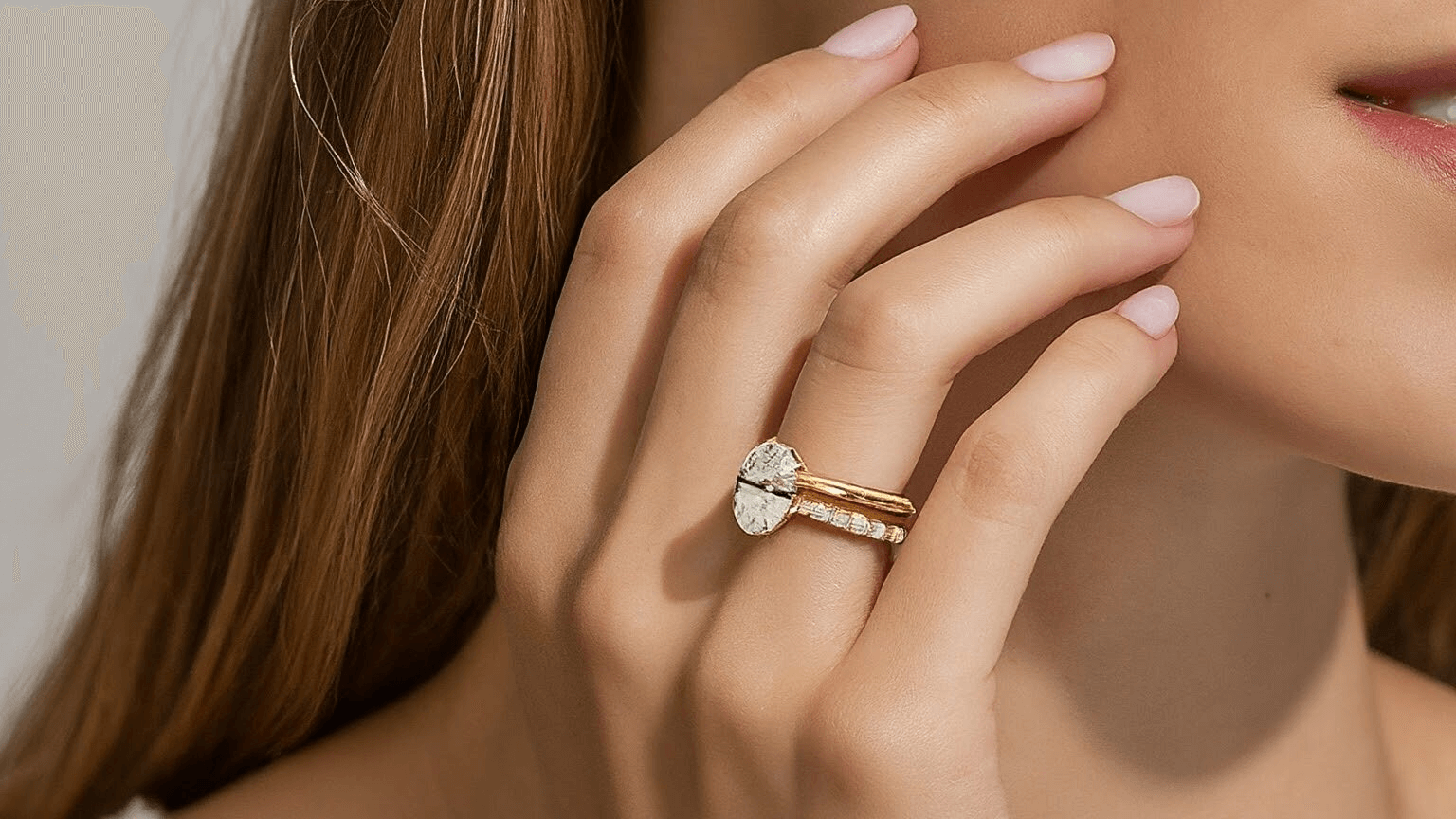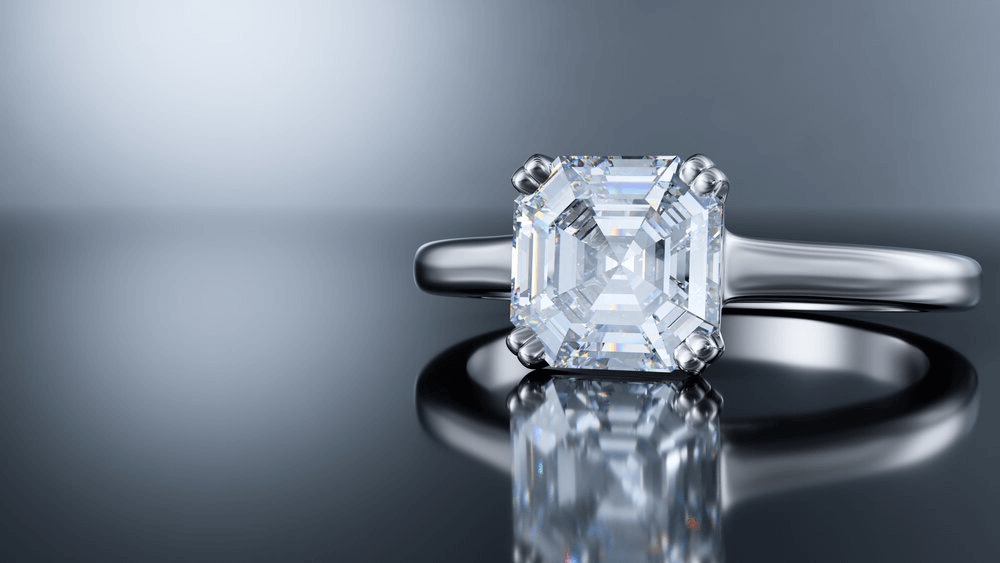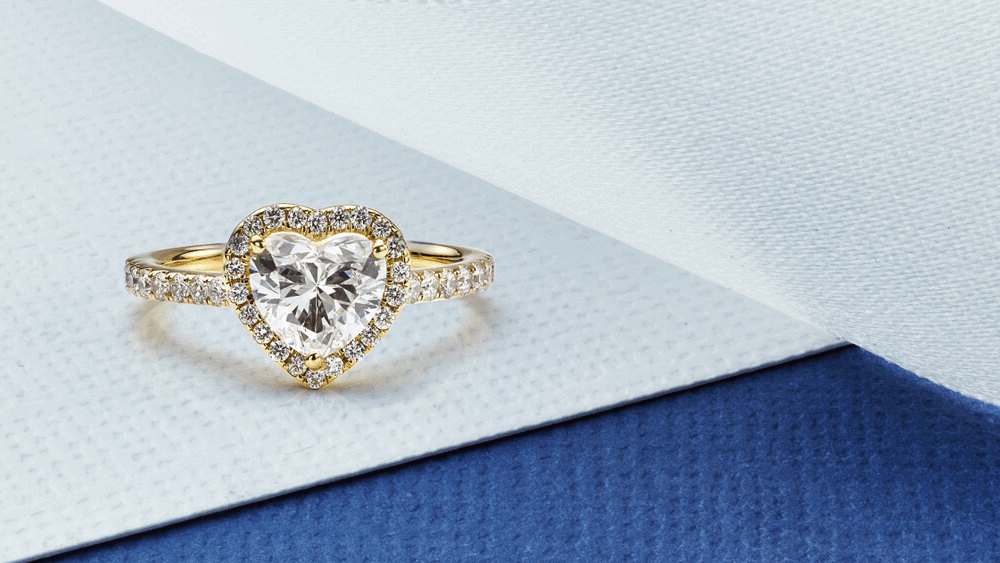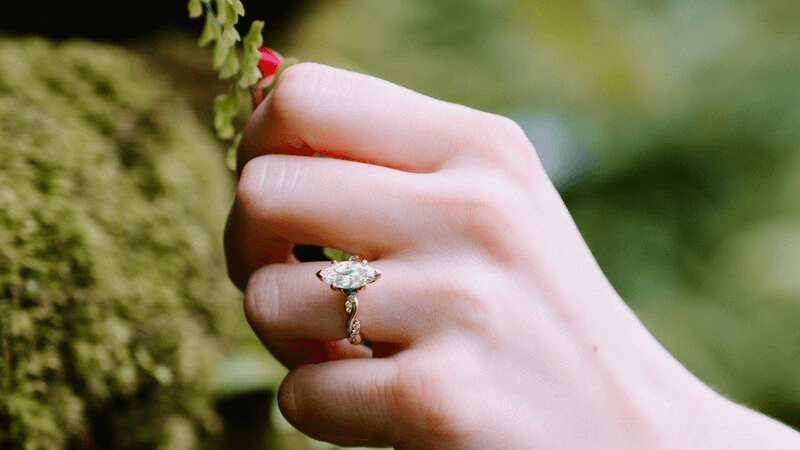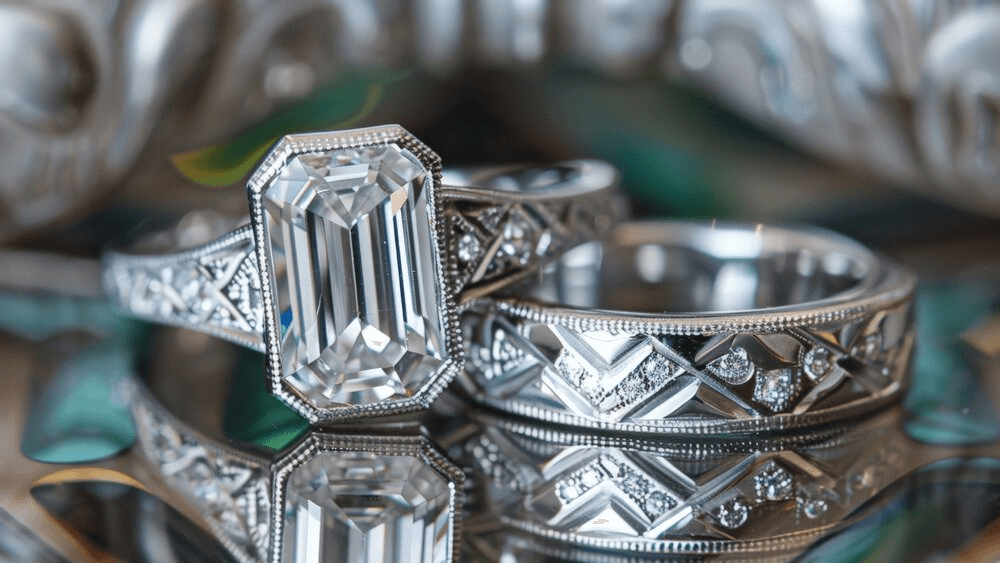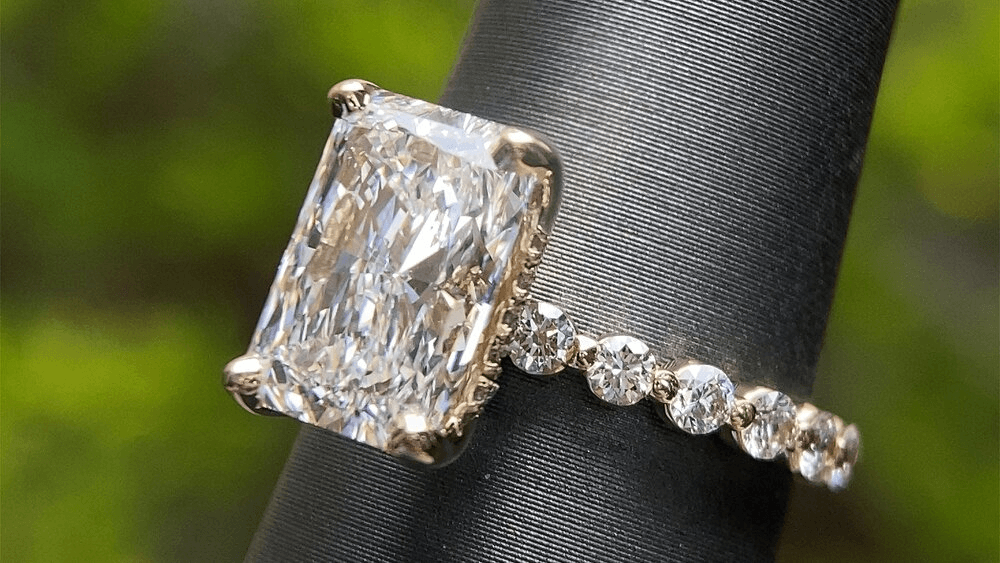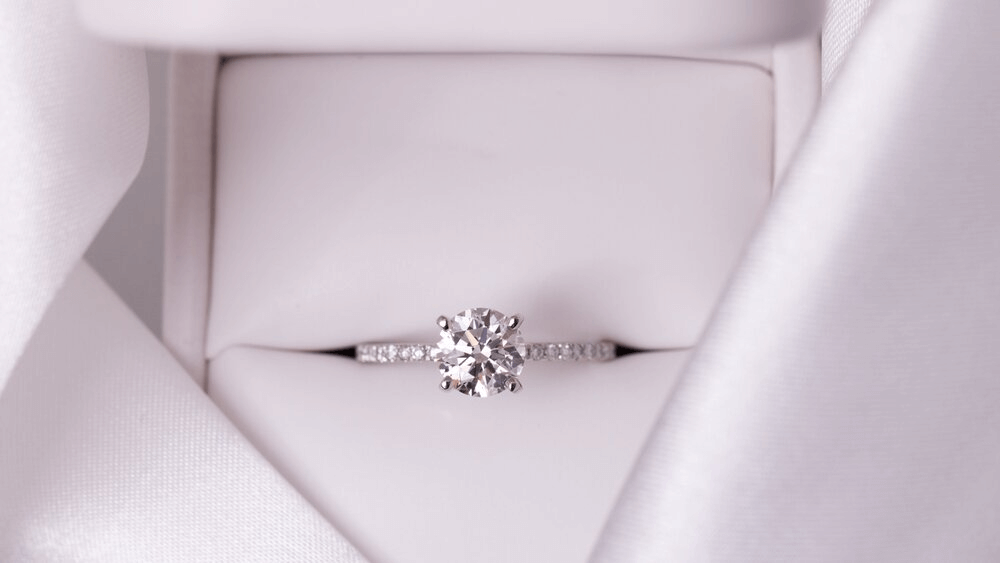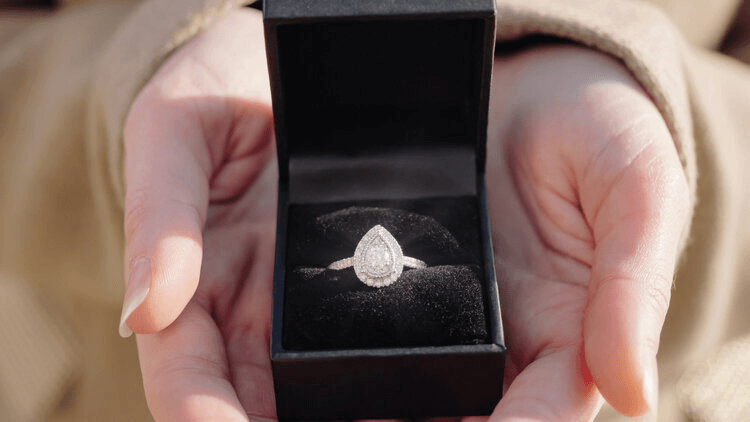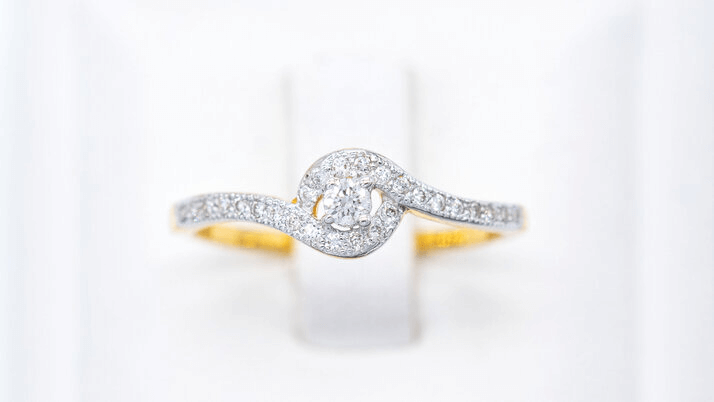Wow Her with Side Stone Engagement Rings

By Gary A.

Edited by Olivia H.
Published Aug 13, 2024
Edited on Mar 31, 2025
There’s more than one way to frame a center stone. Read everything you need to know about side stones below.

Navigate this guide:
- 7 Quick Tips for Buying Diamond Engagement Rings with Side Stones
- Introduction to Side Stone Engagement Rings
- The Spectrum of Side Stones
- Selecting the Perfect Side Stones
- Caring for Your Side Stone Ring
- Our Expert Take: Making Your Choice
- 10 Frequently Asked Questions About Side Stone Engagement Rings
Before we dive deeper into the specifics, here are some practical tips to help guide your decision-making process:
7 Quick Tips for Buying Diamond Engagement Rings with Side Stones
When exploring the enchanting world of side stone engagement rings, whether you’re drawn to the allure of Trillion Cut Diamonds, the geometric beauty of Trapezoid and Hexagon Diamonds, or the unique charm of Epaulette and Bullet Diamonds, paying attention to certain practical aspects can ensure your investment is both beautiful and wise. Here are critical tips to consider:
- Tip : Understand the 4 Cs
Before venturing into the specifics of side stone rings, grasp the basics of the 4 Cs: Cut, Color, Clarity, and Carat weight. While these criteria primarily apply to the center stone, the side stones should ideally match or complement these qualities to enhance the ring’s overall harmony and brilliance.
- Tip : Consistency in Quality
Aim for uniformity in the quality of the side stones relative to the center diamond. Disparities in color and clarity between the center and side stones can detract from the ring’s beauty. A well-matched set will create a seamless and captivating appearance, ensuring the ring’s components work together rather than against each other.
- Tip : Setting Security
Examine the security of the setting, particularly for side stones. Side stones, given their placement and size, might be more vulnerable to loosening over time. Whether they’re prong-set, channel-set, or bezel-set, confirm that each stone is securely mounted to avoid potential loss or damage.
- Tip : Balance in Design
Ensure the design’s balance is maintained by choosing side stones that complement rather than overshadow the center diamond. Consider the size, shape, and placement of the side stones carefully; they should serve to accentuate the center stone’s features, creating a cohesive and attractive ensemble.
- Tip : Metal Matters
The metal you choose for the ring setting can significantly impact the overall look of the engagement ring. White metals like platinum and white gold can enhance the brilliance of the diamonds, making them appear larger and more vibrant. Conversely, yellow or rose gold settings can offer a warmer, more traditional appearance, which might better suit certain diamond colors and shapes.
- Tip : Ring Proportions
A ring’s balance on the finger is crucial. It should not feel top-heavy or uncomfortable between the fingers. The proportion and arrangement of side stones can significantly influence how the ring sits on the finger, its comfort level during daily wear, and its aesthetic appeal.
- Tip : Flexibility for Future Modifications
Fashion and personal tastes evolve; what’s appealing today might change. Selecting a ring setting that allows for future adjustments or upgrades, whether to the diamonds or the setting itself, can provide peace of mind and flexibility for years to come.
Now that you’ve got these practical tips, use Jeweler AI below to find the perfect engagement ring that suits your style and budget:
Introduction to Side Stone Engagement Rings
While, for those first few seconds whenever you show that ring off, all eyes are going to be on the diamond at the center, that’s not to say it needs to steal the show entirely.
Other elements of the ring, from the metalwork to, you guessed it, the side stones, all deserve their time ‘under the gaze’ too – and, if you make the right choice, they won’t struggle to get it.
Here’s our full guide to side stones, from the shapes available to finding the right one for your ring.
The Allure of Side Stones
Side stones add extra sparkle, intrigue, and beauty to any ring design. They can really elevate the overall vibe of the ring without stealing attention away from the center diamond, meaning extra brilliance and fire without overloading the ring design with big stones.
While the traditional, single-stone solitaire ring design remains the classic of proposals, adding those side stones to the ‘shoulders’ of your ring really is a great way to maximize light performance and find that ‘wow factor’.
The Spectrum of Side Stones
There are tons of different shapes used for side stone diamonds. Plenty of these shapes are available for larger diamonds – for instance, a baguette engagement ring (featuring the baguette as the center stone) isn’t a common sight.
This is because, while some of these shapes are great for smaller diamonds that aren’t intended to be the main focus of the ring, they simply don’t emphasize a diamond’s best features enough to prove worthwhile to jewelers making engagement rings. The average shopper is going to invest in an emerald cut engagement ring, not a beget engagement ring. If jewelers made a habit of using side stone cuts for center diamonds, they would have a lot of unsold products on the shelves.
This does mean, of course, that there’s a lot more scope for getting creative with your side stones. The spectrum is long, and it’s worth exploring every option before you reach your final decision. A lot of people still opt for the classics, but, if you’re willing to sacrifice a little of the sparkle that you’d get from a round cut side stone, going off the beaten path can be a great option.
Trillion Cut Diamond
Trillion cut diamonds are particularly popular for engagement ringside stones. Featuring a triangular silhouette – an equilateral triangle, for those who remember high school trig – and between 31 and 50 facets, the trillion cut is known for its brilliant sparkle at this versatility when positioned on either side of a center stone. With one flat side against that center stone, the overall silhouette of her ring with trillion cut side stones is striking, but streamlined and sophisticated.
Trapezoid Diamond
Also known as a trap diamond, these side stones feature the shape of a trapezium, with two parallel sides and four sites in total. Again, similar to the trillion cut, these diamonds are great for framing a center stone and creating a sleek overall silhouette for the center setting.
Epaulette Diamond
Like the trillion, epaulette diamonds are triangular, although they’re not equal lengths on all sides. This creates a lengthening effect that can make that center setting appear wider and more impactful than it is.
Bullet Diamonds
Tapered like a real bullet, these diamonds add a sleek and contemporary vibe to an engagement ring.
Half Moon Cut Diamond
As the name suggests, these diamonds appear in the shape of a halfmoon – or, put another way, a semicircle. Of course, that lack of symmetricity means a reduced sparkle, but melee diamonds are great for producing that glitter, even in more unusual shapes.
Kite Shaped Diamond
Kite shaped diamonds have a unique geometric shape, resembling a kite with four sides. They are often used in avant-garde jewelry designs, adding a bold and striking element to any piece.
Cadillac Diamonds
Cadillac diamonds are trapezoid-shaped with three distinct sides and a pointed tip – so, unlike the trapezoid shape, they don’t have a flat top – resembling the fin of a classic Cadillac car. They are typically used as side stones to frame a central diamond.
Calf Cut Diamond
Calf cut diamonds feature a unique, elongated shape with soft, rounded corners. They are less common but provide an elegant and distinctive look for those seeking something different. They look a little like the silhouette created by a diamond viewed from the side, though, instead of ending in a sharp point, there’s a blunt base to the shape – like a large culet.
Shield Cut Diamond
Shield cut diamonds have a shape that resembles a medieval shield, with a pointed top and a broad base. This shape isn’t common in ready-to-wear designs but has proven popular in bespoke jewelry designs.
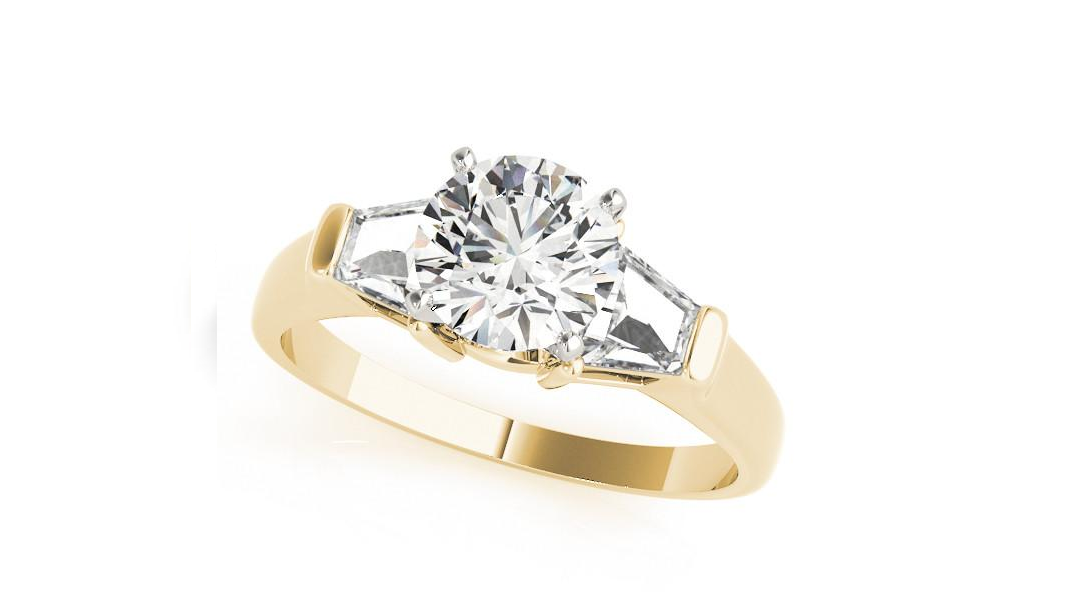
Tapered Baguette
Tapered baguette diamonds are rectangular with a slight taper, making one end narrower than the other. They are frequently used as side stones, adding a subtle, sophisticated touch to the main diamond. A great example can be found in Princess Grace Kelly’s engagement ring.
Octagon Cut Diamond
Octagon cut diamonds feature eight sides and are often step-cut, similar to emerald cuts. This shape offers a refined, elegant look; what you lack in sparkle from these diamonds, you make up for in the emphasis they place on clarity and color.
Hexagon Diamond
Hexagon diamonds have six equal sides and a modern, geometric appearance. This cut is increasingly popular in contemporary jewelry designs, providing a unique and eye-catching alternative to traditional shapes.
Selecting the Perfect Side Stones
Ask yourself what you want your side stones to do. Obviously, they don’t necessarily have to do anything – some things perfectly happy to be there simply because they’re beautiful. But, most people know whether they want their side stone to play to a certain vibe or style, or whether they simply want to get an extra boost of sparkle.
Matching with the Center Stone
In general, you should think about your side stones as a complement to your centre stone, not the main part of the ring. It may sound obvious to say, but think about it from this perspective: it’s imperative that your side stones don’t throw off the balance of your ring, and if they do, the side stones should change, not the centre stone. In other words, if there’s a problem with the design, consider the side stones the problem.
So, when you’re choosing your side stone shape, you should think about it through the following question: which shape will bring balance to my centre stone?
Generally, it is best to avoid matching the shape of your centre and side stones, or the ring will look like a three stone design. Three stone engagement rings are beautiful, but they’re not what everyone wants. Shapes like the trillion are great for framing a symmetrical centre stone, like a Round cut, whereas rectangular or square shapes are great for bringing balance to an asymmetrical cut, like the pear.
Setting and Security Considerations
In any well-made ring design, those side stones will be a lot more secure than they look. In fact, the mark of a great jeweller is their ability to make a diamond look precariously placed, when, in reality, it’s very safe.
Obviously, a setting like the bezel is a lot more secure than prongs, but, either way, just focus on finding a reputable jeweller and you will be fine. Take it in for regular tune-ups, and don’t do any heavy lifting with it on.
Caring for Your Side Stone Ring
Picking an engagement ring design with side stones inevitably means more nooks and crannies. Just like the centre diamond, those side stones need to be held in place with settings like prongs or half bezels, which simply means that there are more places for dirt and oils to accrue throughout the day.
This doesn’t need to be a deal breaker. You just need to stay on top of your ring care and consider visiting a jeweller once or twice a year to get it checked over under the microscope.
Maintenance Tips for Longevity
Read our comprehensive guide to ring care to find out how to stay on top of cleaning and maintenance.
Our Expert Take: Making Your Choice
Your side stones are a great opportunity to explore something a little different, get some extra sparkle in your ring without detracting from the centre diamond, and make the overall design totally your own.
However, always keep in mind that there is nothing wrong with going with the classics. A round brilliant side stone, while not the most aerodynamic, will bring the most sparkle. The marquise, emerald, and cushion are also popular choices for side stones.
10 Frequently Asked Questions About Side Stone Engagement Rings
- Q: What are side stone engagement rings?
- A: Side stone engagement rings feature smaller diamonds or gemstones placed alongside the main center stone to enhance its appearance and overall sparkle.
- Q: Can I customize the side stones on my engagement ring?
- A: Yes, many jewelers offer customization options for side stones, including their shape, size, and type, to create a personalized look that complements the center diamond.
- Q: Do the side stones have to match the center stone?
- A: While not a strict requirement, matching the side stones with the center stone in terms of color and clarity can create a more cohesive and visually appealing ring.
- Q: How do I choose the right metal for my side stone engagement ring?
- A: Consider the color of the stones and personal preference. White metals like platinum and white gold highlight diamond brilliance, while yellow or rose gold adds warmth.
- Q: Are side stone rings more expensive than solitaire rings?
- A: Side stone rings can be more expensive than solitaires due to the additional diamonds or gemstones. However, the total cost depends on the size, type, and quality of the stones used.
- Q: How do I care for my side stone engagement ring?
- A: Regular cleaning with a soft brush and mild soap, annual check-ups with a jeweler to ensure the stones are secure, and avoiding exposure to harsh chemicals will help maintain its beauty.
- Q: Can side stones be replaced or upgraded later?
- A: Yes, it’s possible to replace or upgrade side stones. However, the feasibility and cost will depend on the original ring design and the desired changes.
- Q: How do side stones affect the overall look of the ring?
- A: Side stones can enhance the ring’s visual impact by adding extra sparkle and making the center stone appear larger and more prominent.
- Q: What shapes are available for side stones?
- A: Side stones come in various shapes, including round, baguette, trillion, pear, and half-moon, allowing for numerous design possibilities.
- Q: Is it possible to have colored gemstones as side stones?
- A: Absolutely, colored gemstones like sapphires, rubies, and emeralds are popular choices for side stones, adding a unique touch to engagement rings.
Discover your dream ring with Jeweler AI – delve into the world of side stone engagement rings and find your perfect match.
FOLLOW-UP GUIDE SERIES





